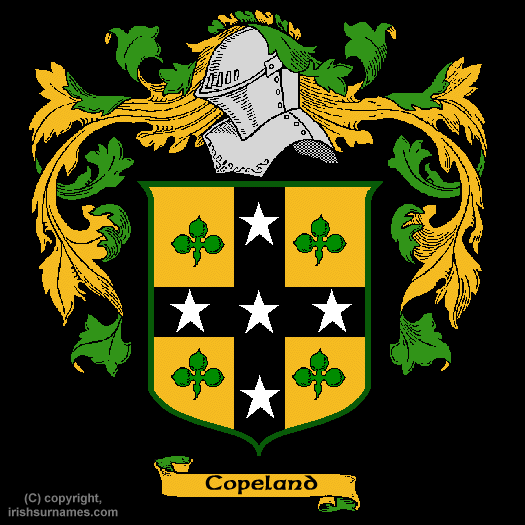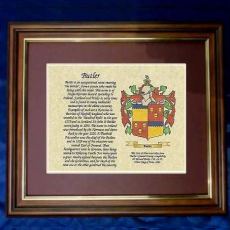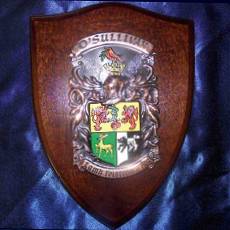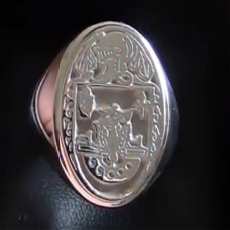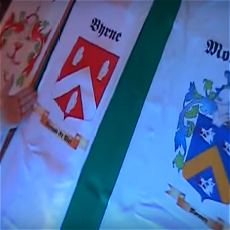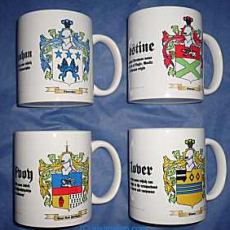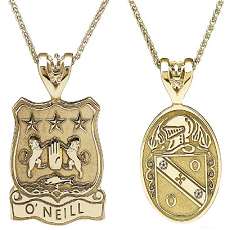Copeland Coat of Arms, Family Crest and Copeland Family History
Copeland Family History
The Copeland ancient family history was found in the irishsurnames.com archives.
Surnames developed a wide number of variants over the centuries. Many different spelling variations of the same name can be traced back to a single original root. Also, when a bearer of a name emigrated from Ireland it was not uncommon that their original name would be incorrectly transcribed in the record books upon arrival at their new location. Some names have dozens of spelling variations. Some Surnames were also altered over the years based on how they sounded phonetically, by their sound, and depending on the prevailing political conditions it may have been advantageous to change a name from one language to another. This was especially so in Ireland where most Gaelic names were 'anglicized' at some stage.
Variants of the name Copeland include Coupland, Copland and Copelan. This is a surname of local or territorial origin from the land of Coupland in the parish of Kirk, meaning of Coupland. This name is usually of Scottish descent and is found in many ancient manuscripts in the above country. Examples of such are a William de Copland who was one of the witnesses to the gift of Dundas to Helias in 1160 and Thomas de Coupland held lands in the vill of Greenlaw in the year 1200.Names were recorded in these ancient documents to make it easier for their overlords to collect taxes and to keep records of the population at any given time. When the overlords acquired land by either force or gifts from their rulers, they created charters of ownership for themselves and their vassals. It was by the method of creating and updating these old reference books that they were able to maintain their authority and enforce laws.
Other examples of this name were found in the person of John de Coupland who was the hero of the Battle of Neville's Cross in 1346.In Ireland this name and its variants were introduced into Ulster Province by settlers who arrived from England and Scotland, especially during the seventeenth century. During the 'Plantations of Ireland' in the sixteenth and seventeenth centuries Ireland was colonized by the English Crown with this period marking the end of Gaelic supremacy in Ireland. This period brought an influx of settlers into the country but, unlike the earlier Anglo-Norman invasion of the twelfth century that resulted in a full integration into Irish society of the new arrivals, the same never occurred with the Ulster Planters who maintained their own distinct identity.
The Copeland family crest (or coat of arms) came into existence many centuries ago. The process of creating these coats of arms began as early as the eleventh century although a form of Proto-Heraldry may have existed in some countries prior to this, including Ireland. The new more formalized art of Heraldry made it possible for families and even individual family members to have their very own family crest, coat of arms, including Copeland descendants.Meaning of Symbols & Colors on the Copeland Coat of Arms
| Or/Yellow/Gold | Represents Generosity. | |
| Sable/Black | Denotes Constancy and sometimes Grief. | |
| Vert/Green | Signifies Hope, Joy and sometimes, Loyalty in Love | |
| Crosses | Often representing Faith or Christian beliefs, possibly relating to the Crusades | |
| Mullet/Star of Five Points | Denotes Virtue, Learning, and Piety. | |
| Shamrock/Trefoil | Signifies Perpetuity |
Wonderful COPELAND Gifts For Every Occasion
Show Off Your Heritage With Our Range OfCopeland Family Crest Gifts
For a Limited Time We Are Offering Free Delivery.


